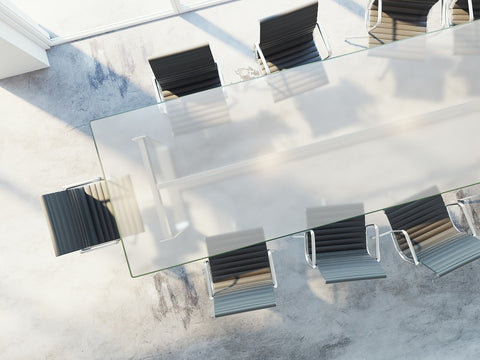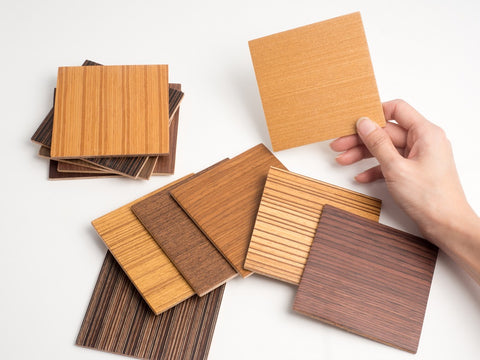When researching which type of standing desk you should purchase, there are a number of variables you need to consider. For instance, the type of tabletop (singular, twin, v-shaped), the size and the color of your tabletop and frame, and the type of tabletop material you wish to opt for.

Progressive Desk offers two types of tabletop materials: Melamine Faced Chipboard (MFC) and Medium Density Fibreboard (MDF). In this article, we will break down the characteristics and performances of our tabletop materials to find which tabletop will suit your needs better, as well as comparing them to other materials such as glass and solid wood.
Popular Tabletop Material Types
Glass

Glass tabletops are very elegant and look great in modern design. They can make a room look larger and enhance the beauty of your space. However, the downside of glass tabletops is that they require regular cleaning to maintain their look as they can easily be dirtied by fingerprints, smudges, dust, or even leave watermarks that are hard to remove. They also need to be treated with extreme care to avoid scratches or damage of any kind.
Further to this, while glass tabletops are extremely appealing, be mindful that everything can be seen underneath the table requiring constant cleanliness and high-quality décor.
Solid Wood

Solid wood is extremely durable and aesthetically-pleasing, regardless of whether it will be your workstation or dining table. The natural texture is a very desirable look, with MDF material being the closest replica of it.
However, there are some downsides to solid wood:
Prone to Moisture
Moisture is not a major issue, especially if your tabletop has a good finish. However, over time you could accidentally damage the surface that will accumulate in significant damage over time. Even the tiniest crack in this surface can result in a colony of fungi and mold.
Vulnerability to Compression/Expansion
Solid wood is affected when there are rapid changes in temperature and humidity. Depending on the hotness or the coldness of the environment, this could cause the wood to lose its overall integrity over time.
Attractive to Pests
Solid wood is known to become a victim of termites. You would require proper chemical treatment for a solid wood tabletop material in order to cut the risk of infestations.
Medium Density Fiberboard (MDF)
MDF is an engineered wood that is easier to cut and shape compared to MFC. This type of material has an exceptionally smooth texture due to the wood fibers being bound together by high heat and pressure. As the fibers are arbitrarily oriented, machines can easily cut them in any direction. MDF boards are highly versatile and have a minimal reaction to moisture.

| FEATURES | FACTORS TO CONSIDER |
|---|---|
|
• Modern looking • Engineered wood with durable, non-toxic powder coating • Does not swell or diminish with humidity • Low maintenance |
• Coasters and placemats will minimize wear and damage • Gentle cleaners remove most surface marks • Can chip and scratch with heavy usage |
Laminate Surface
Regarding the surface of our tabletops, we use laminate material, also known as veneers. Laminate consists of a wood core that is coated with a plastic finish. Laminate tabletops are family-friendly, cost-effective, low-maintenance, and are very versatile. Since laminate is a solid surface, it does not absorb bacteria as some natural solid wood or stone surfaces would. These types of tabletops are easy to clean as you only require soap and water – no polishes or sealers are needed.
Which Material Should You Go For?

There is no true winner here. The tabletop material of your choice would depend on your environment, budget, and the look you would like to go for. However, MDF may be the better choice for a workstation as they allow for more control of the look and design.
We have a variety MDF tabletops to choose from in our vast selection with a variety of colors and sizes to suit your requirements and preferences.
Final Words
While glass, engineered wood, and natural wood all have their own set of pros and cons, your choice will depend on your specific needs and requirements. This article highlighted the key differences and functionalities of one our tabletop materials: MDF. From this article, we hope you can make an educated decision when purchasing your tabletop and have all the required information.
However, if you need further clarification or would simply prefer to speak with us on this topic, contact us and our sales representatives would be delighted to help.








